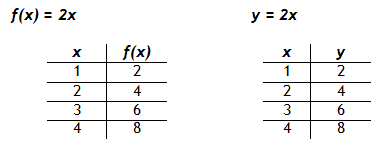Function Notation
Writing Function Notation
A linear function can be written in the form ![]() where
where ![]() represents the output values of the equation or the y-values of the graph. The terms y and f(x) are often used interchangeably. For instance, the expression
represents the output values of the equation or the y-values of the graph. The terms y and f(x) are often used interchangeably. For instance, the expression ![]() clearly shows that x is the independent variable. The values for the dependent variable, y, are calculated when values for x are substituted into the function.
clearly shows that x is the independent variable. The values for the dependent variable, y, are calculated when values for x are substituted into the function.
Function notation is a very compact way of providing information. For example in the function f(3) = 6, the value inside the parentheses is the x value and the value the function equals is the dependent or y value. These two values yield an ordered pair that can be used for graphing the points on the line represented by the function.
Therefore, f(3) = 6 states when x = 3, then y = 6 or that the point (3, 6) is on the line. Review the table of values for both functions below:

Since both tables are the same, then f(x) = 2x is equivalent to y = 2x.